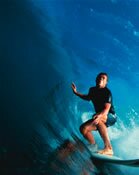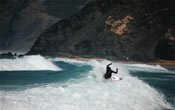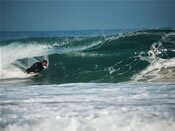Inflight Magazine of Brussels Airlines
Welcome to the Inflight Magazine of Brussels Airlines
Riding high
 Surfing the Algarve
Surfing the Algarve
The Algarve as a surf-trip destination? Forget it. It’s all golf courses and placid coves – surely there isn’t a wave in sight on Portugal’s south coast? Wrong, says Alex Wade
The Algarve might be one of Europe’s best-kept surf secrets, but after two visits I’ve decided it’s one to be reckoned with – for beginners, intermediates and experts alike. Granted, the swells taper off a little in summer, but this is a place where the old surfing mantra applies: seek and ye shall find.
My journey began in Faro, the administrative centre for the region. Faro’s Roman ruins and the legacy of Moorish occupation make for many diversions but, like most surfers, I’m not overly concerned about the weight of history. Surfing is about the here and now, about flow and fluidity.
Riding a wave is a unique sensation. It’s about speed, freedom and exhilaration. And it takes you outdoors, into the ocean where the more you surf, the fitter, healthier and happier you become. John McCarthy, an Irish big-wave surfer, once put it thus: “Surfing is the most blissful experience you can have on this planet. It’s a taste of heaven.”
So where to go in the Algarve to find that taste of heaven? If you’re lucky, you’ll find it almost as soon as you leave Faro airport, because Praia de Faro itself is a beachbreak with peaks all the way along its considerable length. It can have cracking surf all year round, with the swell visible from the plane as it drops down. That’s a pretty good appetiser, but if Praia de Faro isn’t kicking, a drive further west will yield more awesome breaks.
Chris Zinon, centre manager and chief guide for British company Errant Surf Travel’s Algarve operation, confirms: “The surf spots further west are super consistent. The surf is never less than head high, but in winter they’re often too big for most surfers. The good thing is that the south coast breaks are often perfect then. The best thing about surfing on the Algarve – as well as the good weather year-round – is the sheer variety. There’s always a wave somewhere.”
My travels led me to Meia Praia, just outside the pretty town of Lagos. The golden sands of the beach seem to go on forever, and in summer there is surf all the way along. Waves were breaking in classic formation, peeling to both the left and right. Conditions weren‘t big, but it was perfect and, better still, totally uncrowded.
Once you’ve stowed your board for the night, Lagos is brimful with charming restaurants offering excellent Portuguese cuisine. You can’t go wrong with Mullens (tel. ) and O Cantinho Algarvio (tel. ), but if time is short try O Galeao, a traditional, intimate eaterie whose staff embody traditional Portuguese hospitality. It’s on Rua de Laranjeira (tel. ) and the shellfish soup is a must.
 Leaving Lagos is difficult. It boasts a reef break for intermediates and experts as well as miles of beachbreak to the east and west, all of which are perfect for those trying surfing for the first time. I bumped into two novices at Praia Meia, Ali Clintworth and Sarah Green, both 23 and from St Helens in northern England. They had been staying at Errant’s centre and taking lessons from Chris Zinon. “I had no idea there was so much we could do,” said Ali. “When the sea was flat we went mountain biking, snorkelling, swimming and on boat trips. We even had a boxing lesson!”
Leaving Lagos is difficult. It boasts a reef break for intermediates and experts as well as miles of beachbreak to the east and west, all of which are perfect for those trying surfing for the first time. I bumped into two novices at Praia Meia, Ali Clintworth and Sarah Green, both 23 and from St Helens in northern England. They had been staying at Errant’s centre and taking lessons from Chris Zinon. “I had no idea there was so much we could do,” said Ali. “When the sea was flat we went mountain biking, snorkelling, swimming and on boat trips. We even had a boxing lesson!”
Further west, the going gets tougher. There are a number of legendary breaks that should only be tackled by advanced surfers, not least Arrifana, a point break on the west coast a few miles south of Odeceixe, the cut-off point between the Algarve and the plains stretching north to Lisbon. Zinon sums up the dangers: “It’s a right-hand point break that’s protected from all save westerly winds. It’s a great wave, but there’s a huge rock midway. It’s best surfed in seriously big surf, so that the wave is breaking in deeper water and will clear the rock.”
 If that sounds a bit dicey, don’t worry: there are a number of other excellent spots on the south-west tip of Portugal. The focal point for tourists is Sagres, a small town with a bleak, windswept beauty that encapsulates Portuguese writer Jose Saramago’s sense of poetry in “the place where the land meets the sea”. Here are breaks such as Beliche, Tonel, Mareta and Zavial. The latter is a long right-hander with a cover-up section and, as with the vast majority of surf spots on the Algarve, the water quality is excellent.
If that sounds a bit dicey, don’t worry: there are a number of other excellent spots on the south-west tip of Portugal. The focal point for tourists is Sagres, a small town with a bleak, windswept beauty that encapsulates Portuguese writer Jose Saramago’s sense of poetry in “the place where the land meets the sea”. Here are breaks such as Beliche, Tonel, Mareta and Zavial. The latter is a long right-hander with a cover-up section and, as with the vast majority of surf spots on the Algarve, the water quality is excellent.
Sagres, on Cape St Vincent, is also the home of an institute for geographical research founded in the 15th century by Prince Henry the Navigator. The institute was established to teach navigational techniques to Portuguese sailors and its grey ramparts were as important to the Age of Discovery as Cape Canaveral in the space race. A visit to Sagres is a must for even a surfer like me. Then it’s back for a quick surf at Praia de Rocha, another top-quality break, then to Faro for the flight home.
Surf facts
■ The Algarve has south- and west-facing coastlines. In winter, the west-facing surf spots will often be too big for most surfers, but in summer west and north-westerly swells wrap around Cape St Vincent to produce surf along the south coast. The south coast offers excellent year-round conditions for all levels of surfer
■ As with the rest of Europe, experienced surfers are best advised to go to the Algarve in autumn, spring and winter, when larger swells can be expected
■ In summer, the most you will need is a summer wetsuit. Hardier surfers might prefer to surf in boardshorts.
In winter, a 5mm suit with boots should suffice. Water temperature on the Algarve is 12-14°C in January, 18°C in July and August
■ Errant Surf Travel (errantsurf.com) specialises in surf holidays on the Algarve and runs a surf camp just outside Lagos
FR » Voler haut
L’Algarve, une destination pour le surf? N’y pensez pas. On n’y trouve que des terrains de golf et des baies tranquilles. Croyezvous vraiment qu’il n’y a aucune vague en vue sur la côte Sud du Portugal ?
Mais où donc devriez-vous aller en Algarve pour trouver le goût paradisiaque du surf? Avec un peu de chance, vous pourriez le découvrir dès votre arrivée à l’aéroport de Faro, à Praia de Faro même. Là se trouve une plage où les vagues déferlent sur un fond de sable (beachbreak), avec des crêtes élevées tout le long du rivage incommensurable. On peut y pratiquer un surf performant toute l’année, la houle étant visible depuis l’avion lors de sa descente sur Faro. Praia de Faro a de quoi vous mettre en appétit, mais au cas où cette destination ne serait pas assez énergétique, roulez un peu plus loin vers l’Ouest, à la recherche des plus horribles déferlantes.
A Meia Praia, juste en dehors de la belle ville de Lagos, le sable doré de la plage semble se dérouler à l’infini, et en été le surf bat son plein. Mais Lagos a d’autres attraits que les vagues. Ses charmants restaurants offrent une excellente cuisine portugaise. Si vous ne disposez pas de beaucoup de temps, essayez O Galeao (Rua de Laranjeira) un café-restaurant portugais traditionnel et familial.
En allant plus loin vers l’Ouest, l’allure s’accélère. On recense un grand nombre de vagues légendaires qui ne devraient être abordées que par les surfeurs émérites. Dans ce paysage, Arrifana, un spot sur la côte Ouest à quelques kilomètres au Sud d’Odeceixe, n’est pas en reste. Si tout ceci ne semble pas très rassurant, ne vous inquiétez pas, le centre d’intérêt touristique ici est Sagres, qui abrite de sublimes plages pour un vrai break cette fois-ci. On citera notamment Beliche, Tonel, Mareta et Zavial.
De retour vers l’aéroport de Faro, arrêtez-vous une dernière fois pour un plan surf à Praia de Rocha, avant de reprendre votre vol.
NL » Hoog op de golven
De Algarve een ideale surfbestemming? Niet meteen. Je vindt er vooral golfbanen en rustige inhammen. Het is even zoeken naar golven aan de Portugese zuidkust…
Waar in Algarve kun je dan terecht om te surfen? Met wat geluk tref je meteen een eerste surfparadijs aan als je de luchthaven van Faro verlaat. Praia de Faro is immers een branding, met pieken over de hele lengte. Je kunt er het hele jaar door surfen, en de deining is zichtbaar vanuit het vliegtuig. Dat is dus een goed begin. Maar wie meer adembenemende breaks wil, moet beslist verder naar het westen rijden.
Net buiten het mooie Lagos ligt Meia Praia, met zijn eindeloos lange, goudgele stranden. In de zomer kun je er overal surfen. Naast golven heeft Lagos ook nog charmante restaurants die uitstekende Portugese gerechten serveren. Niet veel tijd? Probeer dan O Galeao (Rua de Laranjeira), een traditioneel, gezellig Portugees eethuis.
Verder westwaarts gaat het er nog wilder aan toe. Je vindt er een aantal legendarische breaks voor gevorderde surfers. Zo is er Arrifana, een point break op de westkust een paar kilometer ten zuiden van Odeceixe. Te gevaarlijk? Geen probleem, er is ook nog Sagres, met een paar geweldige breaks zoals Beliche, Tonel, Mareta en Zavial.
Hou op de terugweg naar Faro beslist halt in Praia de Rocha, voor een laatste surfpartij.
Image Getty Images, Sam Ellis
Leave a Reply
